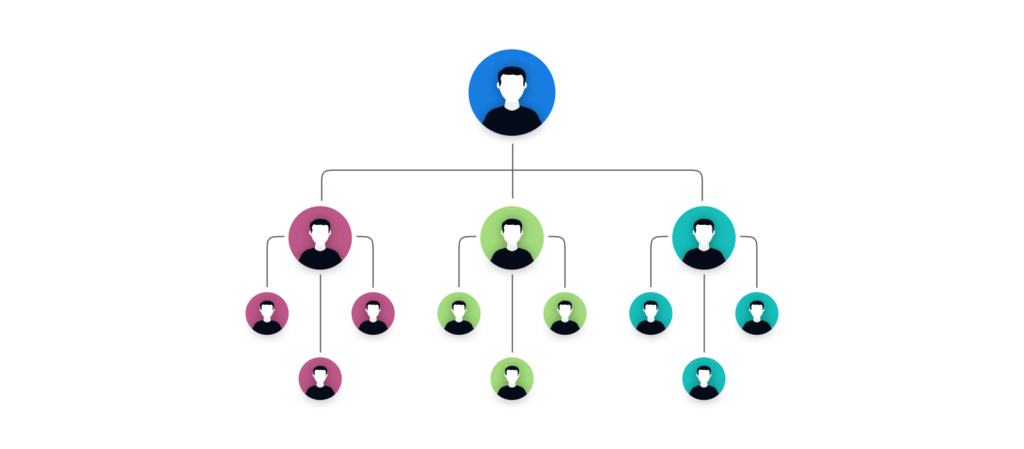
How to Organize Your SaaS Company Structure in 2023
- Angel Alfred
- February 14, 2023

Businesses that operate in the software as a service (SaaS) space require unique organizational strategies to ensure optimal performance and long-term success. To achieve this, several key steps need to be taken. That’s why this blog post will guide how to develop and implement a SaaS company structure.
What is the Purpose of SaaS Companies?
The purpose of SaaS (Software as a Service) companies is to provide software applications over the internet, typically on a subscription basis, to businesses and individuals. These companies aim to simplify software access and usage by eliminating the need for businesses to purchase, install, and maintain software on their computers or servers.
SaaS companies provide a convenient, cost-effective alternative by hosting the software on their servers and delivering it over the internet, allowing users to access it from anywhere, at any time. By offering software as a service, SaaS companies not only save businesses time and resources but also provide regular updates and improvements, ensuring that users always have access to the latest features and functionality.
The purpose of SaaS companies is to simplify software usage and make it more accessible, reliable, and affordable for businesses of all sizes.
Importance of Having a Good Organizational Structure

Having a good organizational structure is critical for the success of any company, but it is especially important in SaaS (Software as a Service) companies. This is because SaaS companies rely heavily on their software and technology to provide services to their customers.
A good organizational structure ensures that the company’s resources are properly allocated and that all employees are working towards a common goal. It helps to streamline communication and decision-making processes, which are essential for a fast-paced and constantly evolving industry like SaaS. With a good organizational structure in place, SaaS companies can operate efficiently, respond quickly to market changes, and stay ahead of the competition.
It helps SaaS companies to establish a strong company culture. SaaS companies often rely on their employees to drive innovation and deliver a high-quality product. By creating a culture that fosters creativity, collaboration, and accountability, SaaS companies can attract and retain top talent.
It also ensures that each employee understands their role and how it contributes to the overall success of the company. This clarity and sense of purpose can boost employee morale, reduce turnover, and lead to higher levels of job satisfaction. Ultimately, a good organizational structure is essential for the growth and success of SaaS companies, helping them to build a strong foundation for sustainable long-term success.
Read: Best SaaS Startup Ideas to Consider in 2023
Different Types of Organizational Structures
Let’s go ahead and talk about the different organizational structures so you can choose one for your SaaS.
Functional Organizational Structure
Functional organizational structure refers to a hierarchical organizational structure in which individuals are grouped by their functional areas of expertise, such as marketing, finance, or operations. The structure aims to enhance efficiency by organizing similar activities and roles in the same department, allowing for specialized knowledge and skill sets to be developed and utilized.
The advantages of a functional organizational structure include clear lines of authority and communication, increased efficiency and productivity, and opportunities for specialization and skill development. Employees are better able to focus on specific functions, and decisions can be made more quickly due to the clear delineation of roles and responsibilities.
However, some of the disadvantages of a functional organizational structure include limited communication and collaboration across departments, the potential for silos, and difficulty in maintaining a customer-focused approach. The structure may create a lack of accountability for overall organizational goals as each department may prioritize its own goals and objectives.
A functional organizational structure is most effective for organizations that prioritize efficiency, standardization, and specialization in their operations. This structure is typically used in larger companies that have diverse functions and departments, such as manufacturing, retail, or service-based organizations. It may not be suitable for smaller organizations or those with a need for more fluid collaboration and cross-functional teamwork.
An example of a company that follows a functional organizational structure is Procter & Gamble. It has a well-defined functional structure with clear lines of authority, and each functional area has its own vice president overseeing it.
Product-Based Organizational Structure
A product-based organizational structure is a type of corporate structure in which a company is divided into smaller, self-contained units based on the specific products or product lines they produce. Each unit operates as a separate business entity and is responsible for its own development, production, marketing, and sales.
Advantages of a product-based organizational structure include a clear line of authority and responsibility, better alignment of the organization’s efforts with its product strategy, improved focus on individual products, and more efficient use of resources. For example, a product-based structure can enable a company to respond more quickly to changes in the market, such as shifts in customer demand or changes in competition.
There are also some disadvantages to a product-based organizational structure. For example, it can lead to duplication of resources and functions and can result in increased bureaucracy and complexity within the company. It can lead to difficulties in coordinating and integrating the activities of different product units, which can negatively impact the company’s overall strategy and competitiveness.
When deciding when to use a product-based organizational structure, it’s important to consider the size, complexity, and nature of the company’s business. A product-based structure is often a good fit for companies that have a portfolio of distinct and well-defined products, such as consumer goods companies, and for companies that operate in highly competitive and rapidly changing markets.
However, it may not be the best choice for companies with a more limited number of products or for companies that operate in more stable and predictable markets.
Geographic Organizational Structure
Geographic organizational structure is a framework that arranges a company’s operations based on geographical regions. Under this structure, a business divides its operations and workforce by geographies, such as countries, states, or cities. Each geographical area operates as a self-contained entity with its own management, sales, marketing, and support functions. This structure is commonly used by multinational companies, which operate in different regions with different business and cultural norms.
One of the primary advantages of a geographic organizational structure is its ability to cater to local market needs. Each region operates independently, and local managers have a deep understanding of the local market and customer preferences.
This allows businesses to tailor their products and services to meet the specific demands of each market. The structure also helps to build stronger relationships with customers, suppliers, and stakeholders in each region, resulting in better customer service, more effective supply chain management, and increased revenue.
Geographic organizational structures also have several disadvantages. One of the main drawbacks is the potential for duplication of resources and functions across different regions. Each region may have its own management, sales, and support teams, which can result in higher costs and inefficiencies. Communication and coordination across regions can be challenging, and it can be difficult to maintain consistent standards across different regions.
When deciding whether to use a geographic organizational structure, companies should consider several factors, such as their business goals, the size of the organization, and the complexity of the markets they operate in.
A geographic structure is ideal for businesses with a diverse product or service portfolio, as it allows them to customize their offerings to meet local market needs.
It is also suitable for large organizations with significant resources, as they can afford the cost of duplicating functions and resources across different regions. Ultimately, the decision to use a geographic organizational structure should be based on a careful evaluation of the company’s needs, resources, and goals.
Matrix Organizational Structure
A matrix organizational structure is a type of organizational structure where employees report to multiple managers or departments simultaneously. It combines functional and project-based reporting lines and is often used in organizations where multiple projects and functions are occurring simultaneously.
Advantages of matrix organizational structure include improved flexibility, increased opportunities for cross-functional collaboration, and better alignment of projects with the organization’s overall strategy.
This structure also provides employees with exposure to multiple areas of the organization and the ability to develop a broad range of skills. It allows organizations to better respond to changing market conditions and customer needs.
However, matrix organizational structures can also have disadvantages. The primary challenge with this structure is managing conflicting priorities and conflicting demands from multiple managers. This can lead to confusion and frustration for employees, and can also result in decreased job satisfaction. The structure can be complex and difficult to implement and manage, particularly in large organizations.
Matrix organizational structures are typically used in organizations where there are a large number of projects and functions occurring simultaneously. They are often used in consulting firms, engineering firms, and technology companies where cross-functional collaboration and project management are essential to success. They are also commonly used in organizations where there is a need for high levels of flexibility and adaptability to changing market conditions and customer needs.
Factors to Consider When Choosing an Organizational Structure
Organizational structure refers to the formal arrangement of lines of authority, communications, rights, and duties within an organization. When choosing an organizational structure, there are several factors that need to be considered in order to ensure that the structure is aligned with the goals and objectives of the organization.
One important factor to consider is the size of the organization. A small organization may require a flat structure with fewer layers of management, while a larger organization may require a more hierarchical structure in order to effectively manage its operations.
Another factor to consider is the type of work being performed within the organization. If the work is highly specialized, a functional structure may be appropriate, while if the work requires close collaboration and coordination among different departments, a divisional structure may be more effective.
Organizational culture is also an important factor to consider when choosing a structure. Some cultures are highly centralized and hierarchical, while others are more decentralized and empowering. The structure should align with the culture of the organization in order to ensure that employees are motivated and engaged.
The goals and objectives of the organization must also be taken into account when choosing a structure. The structure should support the achievement of these goals by providing clear lines of authority, communication, and decision-making processes.
It is important to consider the external environment in which the organization operates. The structure should be flexible enough to adapt to changes in the external environment, such as changes in market conditions or competition, in order to remain competitive and achieve its goals.
In conclusion, choosing an organizational structure involves careful consideration of several factors, including the size of the organization, the type of work being performed, the organizational culture, the goals and objectives, and the external environment.
By considering these factors, organizations can select a structure that is aligned with their goals and objectives and supports their success.
Wrapping Up
The success of your SaaS company depends largely on how you decide to structure it. Organization is key for keeping your company running smoothly and for keeping up with the ever-evolving tech landscape. By understanding the common roles and responsibilities in a SaaS company and designing a structure that works for you, you can ensure that your employees are working together to reach success.
Share This Post
Angel Alfred
Angel is a digital marketer, a mental health speaker, and above all, a writer. She loves being a part of the RocketHub team and is keen on learning and taking over new challenges every day!
Table of Contents
Get The Latest Updates
Subscribe To Our Weekly Newsletter
Sign up below to be one of the first crew members onboard and get early access to amazing deals.
Recent Posts


Social Media
Categories
Related Posts

Lifetime Deal Platforms
The best lifetime deal platforms for software. Platforms lik RocketHub scour the web for the highest quality products to bring buyers the best lifetime deals on their platform.

How to Work for Yourself + 13 Solo Business Ideas
Do you ever wonder if being your own boss could truly set you free? In this article, we’ll explore the theory that unleashing entrepreneurial freedom

7 Reasons Why Every SaaS Team Needs Interactive Demos
Making a Case for Interactive Demos: 7 Reasons Why Every SaaS Team Needs Them Let me paint a scenario for you. You want to buy


